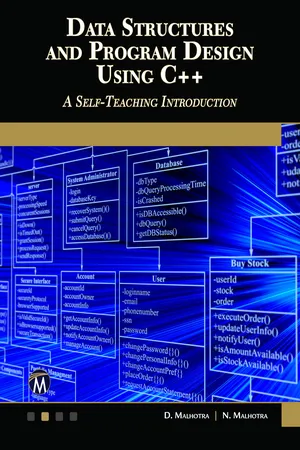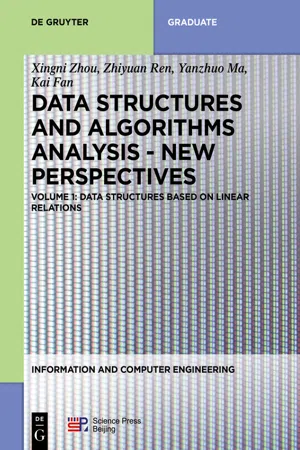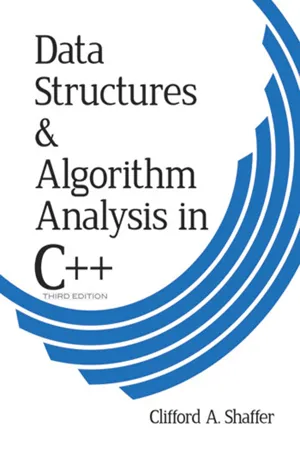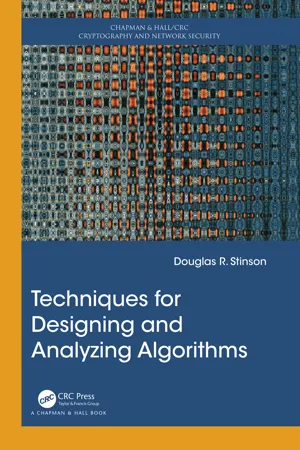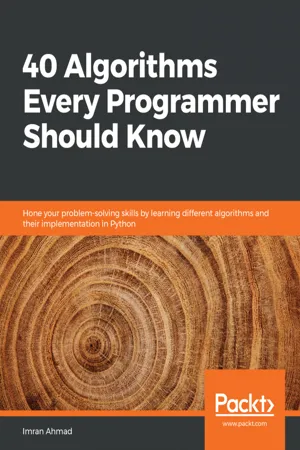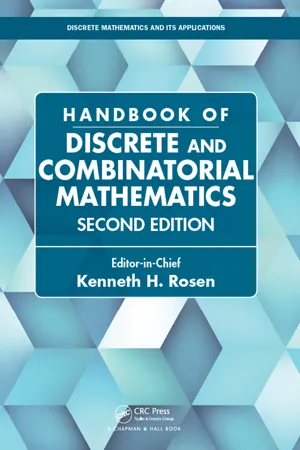Computer Science
Data Structures
Data structures are a way of organizing and storing data in a computer so that it can be accessed and used efficiently. They provide a means to manage large amounts of data and enable efficient algorithms to be developed for processing and manipulating that data. Common examples of data structures include arrays, linked lists, and trees.
Written by Perlego with AI-assistance
Related key terms
12 Key excerpts on "Data Structures"
- eBook - ePub
Data Structures and Program Design Using Python
A Self-Teaching Introduction
- D. Malhotra, N. Malhotra(Authors)
- 2020(Publication Date)
- Mercury Learning and Information(Publisher)
CHAPTER 1INTRODUCTION TO Data Structures1.1 INTRODUCTIONA data structure is an efficient way of storing and organizing the data elements in a computer’s memory. Data means a value or a collection of values. Structure refers to a method of organizing the data. The mathematical or logical representation of data in the memory is referred to as a data structure. The objective of a data structure is to store, retrieve, and update the data efficiently. A data structure can be considered as all the elements grouped under one name. The data elements are called members, and they can be of different types. Data Structures are used in almost every program and software system. There are various kinds of Data Structures that are suited for different types of applications. Data Structures are the building blocks of a program. For a program to run efficiently, a programmer must choose the appropriate Data Structures. A data structure is a crucial part of data management. As the name suggests, data management is a task that includes different activities, like the collection of data and the organization of data into structures. Data Structures are used in stacks, queues, arrays, binary trees, linked lists, and hash tables.A data structure helps us to understand the relationship of one element to another element and organize it within the memory. It is a mathematical or logical representation or organization of data in the memory. Data Structures are extensively applied in the following areas:• Compiler Design• Database Management Systems (DBMS)• Artificial Intelligence• Network and Numerical Analysis• Statistical Analysis Packages• Graphics• Operating Systems (OS)• SimulationsThere are many applications in which different Data Structures are used for their operations. Some Data Structures sacrifice speed for the efficient utilization of memory, while others sacrifice memory utilization and result in a faster speed. - eBook - ePub
- D. Malhotra, N. Malhotra(Authors)
- 2019(Publication Date)
- Mercury Learning and Information(Publisher)
1INTRODUCTION TO Data Structures
In This Chapter• Introduction• Types of Data Structures• Operations on Data Structures• Algorithms• Approaches for designing an algorithm• Analyzing an algorithm• Abstract data types• Big O notation• Summary1.1 Introduction
A data structure is an efficient way of storing and organizing the data elements in the computer memory . Data means a value or a collection of values. Structure refers to a method of organizing the data. The mathematical or logical representation of data in the memory is referred as a data structure. The objective of a data structure is to store, retrieve, and update the data efficiently. A data structure can be referred to as elements grouped under one name. The data elements are called members, and they can be of different types. Data Structures are used in almost every program and software system. There are various kinds of Data Structures that are suited for different types of applications. Data Structures are the building blocks of a program. For a program to run efficiently, a programmer must choose appropriate Data Structures. A data structure is a crucial part of data management. As the name suggests, data management is a task which includes different activities like collection of data, organization of data into structures, and much more. Some examples where Data Structures are used include stacks, queues, arrays, binary trees, linked lists, hash tables, and so forth.A data structure helps us to understand the relationship of one element to another element and organize it within the memory. It is a mathematical or logical representation or organization of data in memory. Data Structures are extensively applied in the following areas: - eBook - ePub
IT Interview Guide for Freshers
Crack your IT interview with confidence
- Sameer S Paradkar(Author)
- 2019(Publication Date)
- BPB Publications(Publisher)
HAPTER 4Data Structures and Algorithms
T his chapter presents an exhaustive question bank on Data Structures with special emphasis on practical scenarios and business cases for key topics. This chapter and the next chapter covers all key domains, including Data Structures, OOPs, DBMS, OS, and methodologies and processes, and trending programming languages.This chapter covers the topic of Data Structures in the programming languages, which essentially provides a number of data types and methods that can be performed on these data types. This chapter covers the core concepts, principles, collections, algorithms, programming standards, and other key topics. A data structure is a concrete implementation of the common data types, that is, linked lists, stacks, queues, maps, and many more, which are covered in this chapter. Different Data Structures are suited for different application requirements, and a select few are specialized for specific tasks. For example, compilers leverage hash tables to research identifiers where-as RDBMS typically leverage B-tree indexes for data retrieval.Concepts
What is a data structure?
Data Structures provide functions used to manipulate large size data efficiently; for example, internet indexing solutions or databases. Effective Data Structures are fundamental to architecting optimal applications. Design strategies and programming languages emphasize on these Data Structures instead of algorithms, as they are critical factors in software applications. Data Structures are leveraged to structure the storage and retrieval of information stored in both primary and secondary memory.As mentioned earlier, anything that stores data can be called as a data structure ; hence, an integer, Boolean, char, float, and more. Each of them is a data structure and so are referred to as Primitive Data Structures . Additionally, there are some complex Data Structures, which are accustomed to storing large and linked data. Some examples of Abstract data structure - eBook - ePub
- Xingni Zhou, Zhiyuan Ren, Yanzhuo Ma, Kai Fan, Xiang Ji(Authors)
- 2020(Publication Date)
- De Gruyter(Publisher)
Since the organizational form and methods of representation are directly related to the processing efficiency of the program on data, and system programs as well as many applications are large scale and complex in structure, and mainly process nonnumeric data, it is really hard to design efficient and reliable programs only relying on the experience and skills of coders. Therefore, there is a need for systematic studies of the objects processed by computer programs. Studies on the characteristics of nonnumeric data and how to represent and implement the operations on them – Data Structures – have then become a specific research field in computer science.Knowledge ABC The relation between mathematics, algorithms and Data StructuresWhen we directly face and solve the problems from the perspective of mathematics and machines, Data Structures and algorithms are born. Algorithm and Data Structures are cross-disciplinary subjects across three subjects: mathematics, computer software and computer hardware. Algorithm can be interpreted as “the concrete solutions to general programming problems.”Actually, Data Structures and algorithm solves the most limited, most fundamental problems in the whole programming process. It only solves limited problems such as the organization of memory and the support of operations on data stored in such memory (e.g., sorting and lookup).As an important branch of computer science, the study of Data Structures and algorithm involves constructing the two building blocks of problem-solving process of computers: Data Structures describe the information in practical problems and its inherent relations; algorithms describe solutions to problems.Normally, Data Structures are connected and organized according to the inherent logic of data elements. The description of the logic relation between data elements is called the logical structure of data. Data must be stored on the computer; the storage structure of data is the form of implementation of data structure and is their internal representation in the computer. Besides, the discussion about a data structure is only meaningful when the operations on this type of data are also discussed at the same time. A logical data structure can have multiple storage structures. Based on different storage structures, the efficiency of data processing can vary a lot. - eBook - ePub
Learn Data Structures and Algorithms with Golang
Level up your Go programming skills to develop faster and more efficient code
- Bhagvan Kommadi(Author)
- 2019(Publication Date)
- Packt Publishing(Publisher)
Data Structures and Algorithms
A data structure is the organization of data to reduce the storage space used and to reduce the difficulty while performing different tasks. Data Structures are used to handle and work with large amounts of data in various fields, such as database management and internet indexing services.In this chapter, we will focus on the definition of abstract datatypes, classifying Data Structures into linear, nonlinear, homogeneous, heterogeneous, and dynamic types. Abstract datatypes, such as Container, List, Set, Map, Graph, Stack, and Queue, are presented in this chapter. We will also cover the performance analysis of Data Structures, choosing the right Data Structures, and structural design patterns.T he r eader can start writing basic algorithms using the right Data Structures in Go.Given a problem, choosing the data structure and different algorithms will be the first step. After this, doing performance analysis is the next step. Time and space analysis for different algorithms helps compare them and helps you choose the optimal one - Clifford A. Shaffer(Author)
- 2012(Publication Date)
- Dover Publications(Publisher)
This first chapter sets the stage for what is to follow, by presenting some higher-order issues related to the selection and use of Data Structures. We first examine the process by which a designer selects a data structure appropriate to the task at hand. We then consider the role of abstraction in program design. We briefly consider the concept of a design pattern and see some examples. The chapter ends with an exploration of the relationship between problems, algorithms, and programs.1.1 A Philosophy of Data Structures
1.1.1 The Need for Data Structures
You might think that with ever more powerful computers, program efficiency is becoming less important. After all, processor speed and memory size still continue to improve. Won’t any efficiency problem we might have today be solved by tomorrow’s hardware?As we develop more powerful computers, our history so far has always been to use that additional computing power to tackle more complex problems, be it in the form of more sophisticated user interfaces, bigger problem sizes, or new problems previously deemed computationally infeasible. More complex problems demand more computation, making the need for efficient programs even greater. Worse yet, as tasks become more complex, they become less like our everyday experience. Today’s computer scientists must be trained to have a thorough understanding of the principles behind efficient program design, because their ordinary life experiences often do not apply when designing computer programs.In the most general sense, a data structure is any data representation and its associated operations. Even an integer or floating point number stored on the computer can be viewed as a simple data structure. More commonly, people use the term “data structure” to mean an organization or structuring for a collection of data items. A sorted list of integers stored in an array is an example of such a structuring.- eBook - ePub
Mesh Generation
Application to Finite Elements
- Pascal Frey, Paul Louis George(Authors)
- 2013(Publication Date)
- Wiley-ISTE(Publisher)
Section 2.5 discusses the manipulation of entities of dimension one (integers). To this end, we look at:• general Data Structures allowing to store, retrieve or analyze sets of objects,• structures allowing a selective access to some entities already stored. The access can be performed according to several criteria of selection. We find here, for instance, the approaches where the smallest item (in some sense), the first or the last recorded, the neighbor(s) of a given item, etc. is sought. Here we will find the Data Structures like stack (LIFO), queue (FIFO), priority queues, array with sorting and binary searching trees.• Data Structures like dictionaries that can provide answers to questions like “does this item exist?” and allow items to be inserted or suppressed. We will find here BST and hash coding techniques.In Section 2.6 , we discuss how to use Data Structures in two and three dimensions for fast storing and retrieving of items such as points, segments (edges) or polygons. Section 2.7 is devoted to the computer implementation of topological data. After this overview of basic Data Structures and algorithms, we discuss robustness problems inherent to any implementation of a mathematical expression in a computer. The degree of the problems and the notion of predicate are then analyzed as well as the cost in terms of the number of operations and of memory requirements (Sections 2.8 and Sections 2.9 ). To conclude, we mention some applications where the previously described material can be used, in the specific context of the development of mesh generation and modification algorithms (Sections 2.10 ).2.2 Elementary structures
In this section, we describe tables (arrays), pointers, lists, stacks and queues. These structures are briefly introduced below on deliberately simple examples.Table or arrayThe table or the array is most certainly the simplest and the most efficient data structure for numerous applications. An array can be simply defined as a fixed set (connected or contiguous) of memory where items of the same nature (more precisely, items having the same storage requirement) are sequentially stored and are accessible by one or several indices. The important point is that an array allowsdirect access to each and any of its elements. Indeed, if the array begins at the addressa and if each item requiresb words of memory to be stored, then the item of indexi starts at the addressa + (i— 1)b. - eBook - ePub
- Mizanur Rahman(Author)
- 2017(Publication Date)
- Packt Publishing(Publisher)
Introduction to Data Structures and Algorithms We are living in a digital era. In every segment of our life and daily needs, we have a significant use of technology. Without technology, the world will virtually stand still. Have you ever tried to find what it takes to prepare a simple weather forecast? Lots of data are analyzed to prepare simple information, which is delivered to us in real time. Computers are the most important find of the technology revolution and they have changed the world drastically in the last few decades. Computers process these large sets of data and helps us in every technology-dependent task and need. In order to make computer operation efficient, we represent data in different formats or we can call in different structures, which are known as Data Structures. Data Structures are very important components for computers and programming languages. Along with Data Structures, it is also very important to know how to solve a problem or find a solution using these Data Structures. From our simple mobile phone contact book to complex DNA profile matching systems, the use of Data Structures and algorithms is everywhere. Have we ever thought that standing in a superstore queue to payout can be a representation of data structure? Or taking out a bill from a pile of papers can be another use of data structure? In fact, we are following data structure concepts almost everywhere in our lives. Whether we are managing the queue to pay the bill or to get to the transportation, or maintaining a stack for a pile of books or papers for daily works, Data Structures are everywhere and impacting our lives. PHP is a very popular scripting language and billions of websites and applications are built using it. People use Hypertext Preprocessor (PHP) for simple applications to very complex ones and some are very data intensive. The big question is--should we use PHP for any data intensive application or algorithmic solutions? Of course we should - Douglas R. Stinson(Author)
- 2021(Publication Date)
- Chapman and Hall/CRC(Publisher)
Chapter 3Data Structures
DOI: 10.1201/9780429277412-3We assume that most students studying design and analysis of algorithms have taken a prior course in basic Data Structures. However, we thought it would be helpful to provide a treatment of some basic Data Structures, for the purpose of review and reference. Therefore, in this chapter, we discuss various aspects of linked lists, stacks, queues, priority queues, binary search trees and hash tables.3.1 Abstract Data Types and Data Structures
In our algorithms, we make use of various kinds of abstract data types, such as stacks, queues, priority queues, etc. We usually think of an abstract data type (or ADT) as consisting of a mathematical model (which typically describes a certain collection of data) together with one or more operations defined on that model. We can define an ADT and then use its operations in an algorithm as needed. On the other hand, when we write a computer program that implements a particular algorithm, we would also have to implement the ADT using a suitable data structure.Typical examples of Data Structures include arrays, linked lists, binary trees, etc. We study these in the following sections of this chapter. A data structure is generally more closely tied to a specific programming language than an ADT is. However, as usual, we present algorithms associated with Data Structures using structured pseudocode, which could subsequently be implemented using various high-level computing languages.If we want to analyze the complexity of an algorithm, then we need to be aware of the complexity of the operations in any ADTs used by the algorithm. Of course the complexity of ADT operations may depend on the specific data structure used to implement the ADT. However, many commonly used ADTs also have standard implementations in which the complexities of the operations in the ADT are predetermined.- eBook - ePub
40 Algorithms Every Programmer Should Know
Hone your problem-solving skills by learning different algorithms and their implementation in Python
- Imran Ahmad(Author)
- 2020(Publication Date)
- Packt Publishing(Publisher)
Data Structures Used in Algorithms
By the end of this chapter, you should be able to understand how Python handles complex Data Structures and which one should be used for a certain type of data. Hence, here are the main points discussed in this chapter:Algorithms need necessary in-memory Data Structures that can hold temporary data while executing. Choosing the right Data Structures is essential for their efficient implementation. Certain classes of algorithms are recursive or iterative in logic and need Data Structures that are specially designed for them. For example, a recursive algorithm may be more easily implemented, exhibiting better performance, if nested Data Structures are used. In this chapter, Data Structures are discussed in the context of algorithms. As we are using Python in this book, this chapter focuses on Python Data Structures, but the concepts presented in this chapter can be used in other languages such as Java and C++.- Exploring Data Structures in Python
- Exploring abstract data type
- Stacks and queues
- Trees
Passage contains an image
Exploring Data Structures in Python
In any language, Data Structures are used to store and manipulate complex data. In Python, Data Structures are storage containers to manage, organize, and search data in an efficient way. They are used to store a group of data elements called collections that need to be stored and processed together. In Python, there are five various Data Structures that can be used to store collections:- Lists : Ordered mutable sequences of elements
- Tuples : Ordered immutable sequences of elements
- Sets : Unordered bags of elements
- Dictionary : Unordered bags of key-value pairs
- Data frames : Two-dimensional structures to store two-dimensional data
Passage contains an image
List
In Python, a list is the main data structure used to store a mutable sequence of elements. The sequence of data elements stored in the list need not be of the same type. - Kenneth H. Rosen, Kenneth H. Rosen(Authors)
- 2017(Publication Date)
- Chapman and Hall/CRC(Publisher)
18 INFORMATION STRUCTURES18.1 Abstract Datatypes18.1.1 Abstract Specification of Records and Databases 18.1.2 Stacks and Queues 18.1.3 Two-Way Sequential Lists 18.1.4 Dictionaries and Random Access Lists 18.1.5 Priority QueuesCharles H. Goldberg18.2 Concrete Data Structures18.2.1 Modeling Computer Storage and Retrieval 18.2.2 Arrays and Linked Lists 18.2.3 Binary Search Trees 18.2.4 Priority Trees and Heaps 18.2.5 Network Incidence StructuresJonathan L. Gross18.3 Sorting and Searching18.3.1 Generic Concepts for Sorting and Searching 18.3.2 Sorting by Expanding a Sorted Subsequence 18.3.3 Sorting by Exchanging Out-of-Order Pairs 18.3.4 Sorting by Divide-and-Conquer 18.3.5 Sorting by Distribution 18.3.6 SearchingJianer Chen18.4 Hashing18.4.1 Hash Functions 18.4.2 Collision ResolutionViera Krnanova Proulx18.5 Dynamic Graph Algorithms18.5.1 Dynamically Maintainable Properties 18.5.2 Techniques 18.5.3 Applications 18.5.4 Recent Results and Open Questions INTRODUCTIONJoan Feigenbaum and Sampath KannanInformation structures are groupings of related information into records and organization of the records into databases. The mathematical structure of a record is specified as an abstract datatype and represented concretely as a linkage of segments of computer memory. General chapter references are [AhHoUl83], [Kn97], and [Kn98].- eBook - ePub
Memory and the Computational Brain
Why Cognitive Science will Transform Neuroscience
- C. R. Gallistel, Adam Philip King(Authors)
- 2011(Publication Date)
- Wiley-Blackwell(Publisher)
9 Data StructuresWe come now to consider the architectural aspect of a full-powered (Turing complete) computing device that gives the symbol processing-machinery unrestricted access to the information-carrying symbols in its memory. The key to such unrestricted access is an addressable read/write memory – memory that can be located, read from, and written to. The architecture must be capable of symbolizing its own memory locations (addresses) using encoding symbols. That is, the machine must have a representation of its memory locations, making it possible to encode the relations between symbols (forming more complex symbols) by virtue of the symbols’ relation to one another within the memory. This same aspect of the architecture allows for the creation of new symbols – symbols that aren’t present in the system at its inception.Memory structures in which the relations between symbols are encoded via their topological relationships within memory are what computer scientists call Data Structures. As we discussed in Chapter 5, a data structure is a complex symbol. Its constituents are themselves symbols. The referent of the data structure is determined by the referents of its constituents and the syntactic (physical) relation between them.A minimal example of a data structure is an integer encoded in binary. Each bit serves to indicate a power of two, and which power of two is indicated by the relative position of the bits. What makes this a data structure, as opposed to being simply an encoding symbol, is that it is composed of symbols (the bits) that are placed in topological relation to each other (a linear order). Which bits are where within the string determines the referent. Contrast this to an encoding where an integer is encoded using an analog property such as the number of molecules in a “bag.” Here, the symbol is still an encoding symbol as the referent can be determined by a compact procedure (simply “weigh” the bag). However, as the symbol has no constituent structure, combinatorial syntax becomes impossible. Trying to form more complex symbols using this technique becomes problematic (Fodor & Pylyshyn, 1988).
Learn about this page
Index pages curate the most relevant extracts from our library of academic textbooks. They’ve been created using an in-house natural language model (NLM), each adding context and meaning to key research topics.

